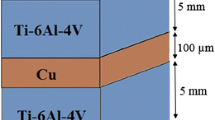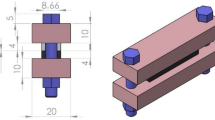Abstract
The efficiency of welded metals depends on the weld metal’s quality to achieve its useful life. The ability of the weld metal to meet the abovementioned requirements is determined by its physical and mechanical properties. In the present study, eight pairs of specimens were used in four groups for diffusion bonding of St37 to 1.2542 steels such that diffusion bonding was performed on two groups without pressure and two groups with pressure (2 MPa). Then, the groups alternatively underwent deep cryotreatment (DCT) for 10 h; finally, all the groups were tempered at 150 °C for 1 h. The results obtained indicate that, under the non-pressure conditions, DCT had no significant effect on the bond’s strength, while under pressure conditions, the DCT led to a 59% decrease in the bond strength from 15.1 to 6.2 MPa. In addition, in the absence of DCT, applying pressure during the bonding process increased the strength of the bond from 12.0 to 15.1 MPa (25.8%), the reason for which is attributed to an increase in the length of the bond from 160 to 220 μm.









Similar content being viewed by others
References
Filabi MG, Kokabi A, Simchi A (2006) Investigating effect of powder particle size on strength of diffusion bond of alloy of iron–5% copper, metallurgy of powder to plain carbon steels. Int J Eng:41–46
ASM handbook volume 6: welding, brazing, and soldering, ASM International, 1993
Noh S, Kasada R, Kimura A (2011) Solid-state diffusion bonding of high-Cr ODS ferritic steel. Acta Mater 59:3196–3204
Zhang C, Li H, Li MQ (2015) Formation mechanisms of high quality diffusion bonded martensitic stainless steel joints. Sci Technol Weld Join 20:115–122
H. Sabetghadam, A. Zareie Hanzaki, A. Hadian, A. Araei (2008), Investigating effect of time and pressure parameters on mechanical and microstructure properties of diffusion bond of copper-stainless steel 410 with Ni interlayer, 2th Joint Conference of Iranian Metallurgical Engineers and Iranian Metal Casters Community, Islamic Azad University, Karaj Branch, Karaj, pp. 1–10
Sharma G, Dwivedi DK (2017) Diffusion bonding of pre-friction treated structural steel with reversion of deformation induced grains. Mater Sci Eng A 696:393–399
Yang Z-h, Shen Y-f, Wang Z-y, Cheng J-l (2014) Tungsten/steel diffusion bonding using Cu/W–Ni/Ni multi-interlayer. Trans Nonferrous Metals Soc China 24:2554–2558
Yuan X, Tang K, Deng Y, Luo J, Sheng G (2013) Impulse pressuring diffusion bonding of a copper alloy to a stainless steel with/without a pure nickel interlayer. Mater Des 52:359–366
Xiong J-t, Xie Q, Li J-l, Zhang F-s, Huang W-d (2012) Diffusion bonding of stainless steel to copper with tin bronze and gold interlayers. J Mater Eng Perform 21:33–37
Atabaki MM, Wati JN, Idris JB (2012) Transient liquid phase diffusion bonding of stainless steel 304 metallurgy and. Mater Eng 18:177–186
Dhokey NB, Hake A, Kadu S, Bhoskar I, Dey GK (2014) Influence of cryoprocessing on mechanism of carbide development in cobalt-bearing high-speed steel (M35). Metall Mater Trans A 45:1508–1516
Vahdat SE, Nategh S, Mirdamadi S (2013) Microstructure and tensile properties of 45WCrV7 tool steel after deep cryogenic treatment. Mater Sci Eng A 585:444–454
Vahdat SE, Nategh S, Mirdamadi S (2014) Microstructure and tensile toughness correlation of 1.2542 tool steel after deep cryogenic treatment. Procedia Mat Sci 6:202–207
Keyhany P, Vahdat SE (2016) Repair of structural steel surface groove by using flame welding method by spraying pure iron powder, archives of foundry. Engineering 16:167–175
Bhadeshia H, Honeycombe R (2017) Chapter 13—weld microstructures. In: Steels: Microstructure Properties. Fourth edition, Butterworth-Heinemann, pp 377–400
K. No, Y.R. Lee, K.J. Min, H.S. Lee (2016) Investigation of microstructure in solid state welded Al-Cu-Li alloy, MATEC Web of Conferences
Exner HE, Arzt E (1990) Sintering processes. In: Sōmiya S, Moriyoshi Y (eds) Sintering Key Papers. Springer Netherlands, Dordrecht, pp 157–184
R.M.i. M., M. S.£¿. (2006) Frenkel’s theory of sintering, Science of Sintering
German RM (2014) Chapter seven—thermodynamic and kinetic treatments, sintering: from empirical observations to scientific principles. Butterworth-Heinemann, Boston, pp 183–226
M.N. Rahaman (2010) 2—kinetics and mechanisms of densification A2—Fang, Zhigang Zak, Sintering of Advanced Materials, Woodhead Publishing, pp. 33–64
Author information
Authors and Affiliations
Corresponding author
Additional information
Recommended for publication by Study Group 212 - The Physics of Welding
Rights and permissions
About this article
Cite this article
Khosravi, N., Niaki, K.S. & Vahdat, S.E. Effect of pressure and deep cryotreatment on strength of diffusion bonds of St37–1.2542 dissimilar steels. Weld World 62, 847–854 (2018). https://doi.org/10.1007/s40194-018-0580-z
Received:
Accepted:
Published:
Issue Date:
DOI: https://doi.org/10.1007/s40194-018-0580-z




